by Vinay Lal
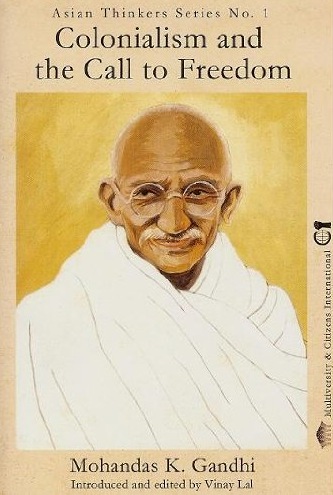
Cover art courtesy Vinay Lal
The enterprise of making a nation is fraught with violence. People have to be not merely cajoled but browbeaten into submission to become proper subjects of a proper nation-state. Overt violence may not always play the primary role in producing the homogenous subject, but social phenomena such as schooling cannot be viewed merely as innocuous enterprises designed to ‘educate’ subjects of the state. One of the most widely cited works to have put forward this argument with elegance and scholarly rigor is Eugen Weber’s Peasants into Frenchmen, where one learns, with much surprise, that even in the Third Republic, “French was a foreign language for half the citizens.” The making of France entailed not only the modernization of the rural countryside but creating, often with violence, proper subjects of a proper nation-state. The making of the United States offers another narrative of the role of violence in the production of the nation-state, with the extermination of Native Americans long before and much after the ‘Revolutionary War’ constituting the most vital link in the long chain of violence that marked the emergence of the United States.
Postcolonial thought, attentive as always to the politics of nation-making and nationalism’s complicity with colonialism, bestowed considerable attention on the various phenomena that can be accumulated under the rubric of violence; however, it had almost no time to spare for a pragmatic, ethical, or even philosophical consideration of nonviolence. The violence of the nation-state may have always been present to the mind of postcolonial theorists, but generally this was reduced to the violence of the colonizer. One thinks, of course, of Fanon, Cesaire, Memmi, and many others in this respect. In those works that have underscored the complicity of nationalist and imperialist thought, a principal motif in the work (say) of Ranajit Guha, the violence of indigenous elites also came under critical scrutiny. (See, for example, Guha’s Elementary Aspects of Peasant Insurgency in Colonial India, Durham, North Carolina: Duke University Press, 1999) It is characteristic of most social thought in the West that it has been riveted on violence – here, postcolonial thought barely diverged from orthodox social science, mainstream social thought, or the general drift of humanist thinking. Nonviolence is barely present in intellectual discussions. We see here history’s continuing enchantment with ‘events’; nonviolence creates little or no noise, it merely is, it only fills the space in the background.
Read the rest of this article »
by Vinay Lal
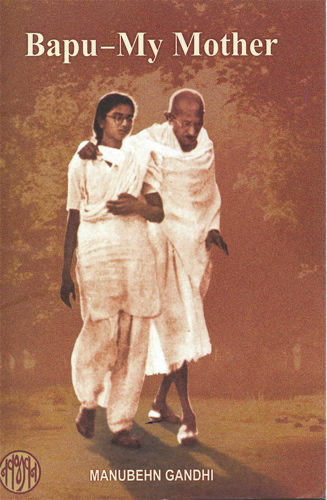
Book cover art courtesy navajivantrust.org
A celibate for the greater part of his life, Mohandas Gandhi continues to attract nearly unrivalled attention – often for the sex that did not take place. Even his friends and admirers, who revered him for bringing ethics to the political life, or for never demanding of others what he did not first demand of himself, were quite certain that Gandhi was unable to comprehend that a woman and a man might enjoy a perfectly healthy sexual relationship with each other. Nehru, seldom critical of the personal life of his political mentor, was convinced that Gandhi harboured an “unnatural” suspicion of the sexual life; and he deplored, as did many others, Gandhi’s strongly held view that sexual intercourse, other than for purposes of procreation, had no place in civilised life – not even among married couples. The Marxists have long subscribed to the view that Gandhi was a “romantic”, a hopeless idealist and even hypocrite; to this a chorus of voices added the thought that Gandhi was an insufferable “puritan”.
Gandhi’s discomfort with the sexual life, according to one widely accepted strand of thought, commenced when his father passed away shortly after his marriage to Kasturba. Though the young Gandhi liked to nurse his ailing father, one evening he was unable to contain his urge to share a night of ribaldry with his young wife. He had just withdrawn to the bedroom when a knock on the door announced that his father had passed away. Gandhi was, it has been argued, never able to forgive himself his transgression, and became determined to master his sexual drive. A more complex narrative links his renunciation of sex to his firm conviction, first developed during the heat of a campaign of nonviolent resistance to oppression in South Africa, that it compromised his ability to be a perfect satyagrahi. Many commentators have pointed to his failure to consult with Kasturba before he took a vow of celibacy at the age of 37 as a sign of his cruelty and tendency to be self-serving.
Read the rest of this article »
by Ken Butigan
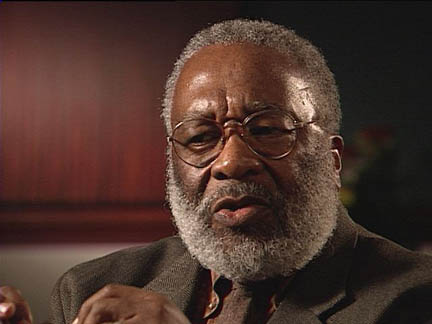
Vincent Harding, c. 2013; photographer unknown.
Historian by profession and relentless nonviolent advocate by calling, Vincent Gordon Harding died on Monday, May 19, at the age of 83. The author of a series of books on the civil rights movement — which he called the Southern Freedom movement — he not only wrote history, but also played an active part in the struggle to make and remake it.
Harding worked with the Student Nonviolent Coordinating Committee, the Southern Christian Leadership Conference, and the Mennonite House in Atlanta, an interracial voluntary service. As part of the Albany, Ga., movement, he was arrested for leading a demonstration at the city hall in 1962. He became a strategist for the movement, and drafted Martin Luther King’s historic 1967 anti-war speech “Beyond Vietnam,” which King delivered at Riverside Church in New York City one year to the day before his assassination.
Read the rest of this article »
by Pace e Bene
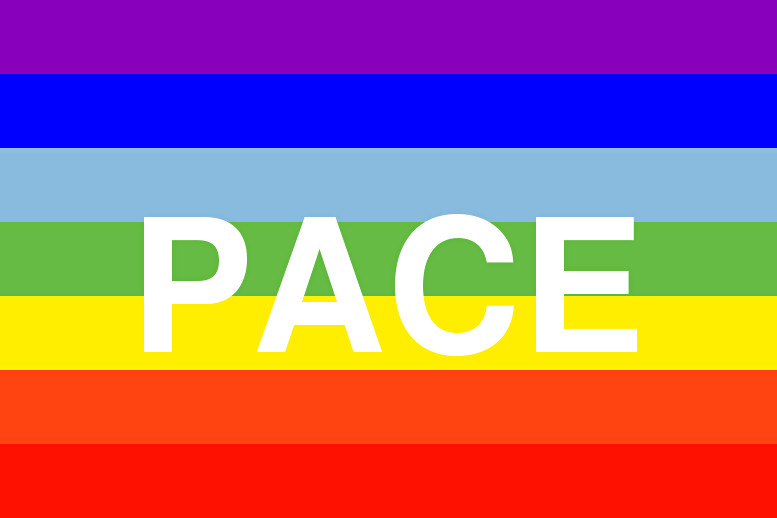
Peace flag by and courtesy of paceebene.org
Editor’s Preface: This continues our series of purpose statements by our nonviolent movement groups. We have already posted those by the Metta Center for Nonviolence, and the Gandhi Information Center in Berlin. Our own purpose is to build an archive of record on the history and culture of nonviolence. Please consult the Editor’s Note at the end for further information and links. JG
Transforming Power
Creative Nonviolence transforms our lives and our world by unleashing our capacity for connection, compassion, and cooperation. It can help us discover: nonviolent options in the face of the conflicts and challenges we deal with every day; tools for nurturing peaceful relationships and tapping healing power in our lives, and ways to mend the broken circles in our communities and in our larger world.
Through this organized love creative nonviolence can:
- Break the cycle of violence
- Free ourselves and others from destructive fear
- Struggle actively for change
- Create a more even playing field
- Celebrate differences while affirming the interdependence of all beings
- Discover constructive and sustainable ways of life
Read the rest of this article »
by Ken Butigan

CO logo courtesy of War Resisters International; www.wri-irg.org
In our present age of permanent war, it is almost impossible to recall a time when armed conflicts clearly began and ended. In that ancient, bygone era, one could judiciously ruminate on an impending war before it got rolling and make a choice about it. Most people, even then, didn’t see it that way — for them there was no choice. If the government said, “War — jump to it,” invariably most of us said, “How high?”, whether that meant picking up a gun, plunking down our taxes, or throwing our full spiritual and political weight behind it. It seemed automatic and inevitable and foreordained. Choice, it seemed, had nothing to do with it at all.
But there was a choice, and some took it seriously. And even today, when war is on a dizzying spin-cycle whirling with such tremendous velocity that it virtually disappears before our very eyes — and when the ever-expanding remote-control battlefield increasingly exceeds every horizon — we still have a choice. Groping our way back to such a decision-point is crucial. Though it will be different than before — a choice made in the midst of the 24/7 careering, never-ending centrifugal spin and not amid the more contemplative lull that we once were afforded before all hell would break loose — this choice must be rescued and learned and applied, given the Pentagon and the National Security Agency’s monotonously relentless planning. What better teachers do we have than those who seized this opportunity in the past? Who better than those who chose.
Read the rest of this article »
by Sean Chabot
Editor’s Preface: An article by Nathan Schneider, which we posted 9 January, drew attention to a controversial essay by Sean Chabot and Majid Sharifi, which we also posted on the same day. Nathan’s article drew a flurry of comments, which bear consulting at this link, and to which Sean Chabot responded. Sean was also kind enough to answer some of our own questions and all of his comments have been edited into the following Guest Editorial. JG
First of all, I want to say that I am grateful to all those who have commented on the article I co-authored with Majid Sharifi, thus initiating a dialogue with critics as well as supporters. It is by sharing our relative (and therefore inherently flawed) glimpses of truth that we improve our individual and collective experiments with truth. I will try to reference the main disagreements and agreements in the hope of providing further clarity.
Read the rest of this article »
by Nathan Schneider
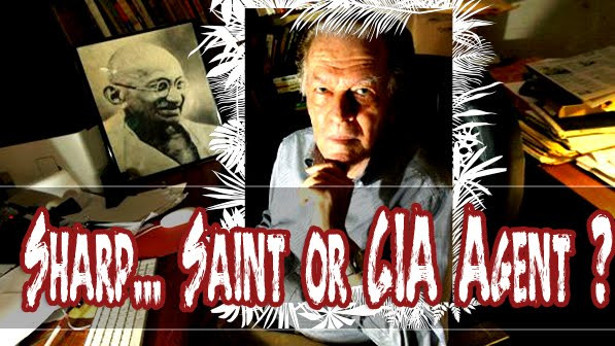
Gene Sharp collage; artist unknown; courtesy of Socialistplatform
There is something of a genre of critique, one sometimes lobbed at Waging Nonviolence, which considers the discourse of nonviolence to be wholly subservient to the U.S. foreign policy interests, and/or the CIA specifically. It’s a line of attack that has generally baffled us, since anything worthy of the name “nonviolence” would certainly run counter to the doings of the largest and most pervasive military machine in the history of the world. Occasionally there seems to be some truth in these critiques, but it’s hard to know where that begins and the conspiracy-theory nonsense ends.
Now I think I know where to begin to draw the line. The reason is a new paper published in the journal Societies Without Borders in September by Sean Chabot and Majid Sharifi. It’s called “The Violence of Nonviolence: Problematizing Nonviolent Resistance in Iran and Egypt.”
Read the rest of this article »
by World Summit of Nobel Peace Laureates
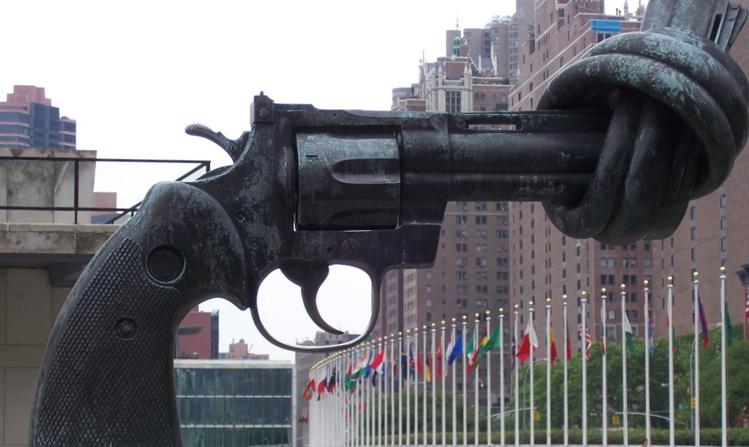
“Knotted Gun”; sculpture by Carl Fredrik Reuterswärd, 1988; at UN building, New York.
Violence is a preventable disease
No state or individual can be secure in an insecure world. The values of nonviolence in intention, thought, and practice have grown from an option to a necessity. These values are expressed in their application between states, groups and individuals.
We are convinced that adherence to the values of nonviolence will usher in a more peaceful, civilized world order in which more effective and fair governance, respectful of human dignity and the sanctity of life itself, may become a reality.
Our cultures, our histories, and our individual lives are interconnected and our actions are interdependent. Especially today as never before, we believe, a truth lies before us: our destiny is a common destiny. That destiny will be defined by our intentions, decisions and actions today.
Read the rest of this article »
by Gandhi Information Center, Berlin
In the name of humanity,
for the sake of all civilians threatened by war crimes,
especially women and children,
and for the benefit of Mother Nature suffering from war preparations and warfare:
We, the undersigned, plead for the universal abolition of conscription as one major and decisive step towards complete disarmament.
We remember the message of 20th century humanists: “It is our belief that conscript armies, with their large corps of professional officers, are a grave menace to peace. Conscription involves the degradation of human personality, and the destruction of liberty. Barrack life, military drill, blind obedience to commands, however unjust and foolish they may be, and deliberate training for slaughter undermine respect for the individual, for democracy and human life. It is debasing human dignity to force men to give up their life, or to inflict death against their will, or without conviction as to the justice of their action. The State, which thinks itself entitled to force its citizens to go to war, will never pay proper regard to the value and happiness of their lives in peace. Moreover, by conscription the militarist spirit of aggressiveness is implanted in the whole male population at the most impressionable age. By training for war men come to consider war as unavoidable and even desirable.” (1)
Read the rest of this article »
by Pace e Bene
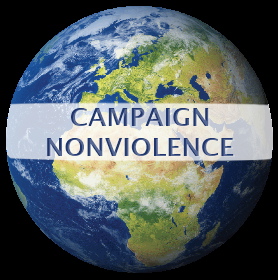
Campaign Nonviolence logo; courtesy of Pace e Bene
“We are constantly being astonished these days at the amazing discoveries in the field of violence. But I maintain that far more undreamt of and seemingly impossible discoveries will be made in the field of nonviolence.”
M. K. Gandhi
The Campaign Nonviolence Pledge commits us to begin or renew our efforts to take up the way of active nonviolence practiced by Mahatma Gandhi and Martin Luther King, Jr. Everyone is invited to take the Campaign Nonviolence Pledge and join this new movement for peace with justice for humanity and creation. Organizations, groups, schools and religious communities are invited to endorse Campaign Nonviolence and to actively collaborate in building this movement.
Read the rest of this article »












